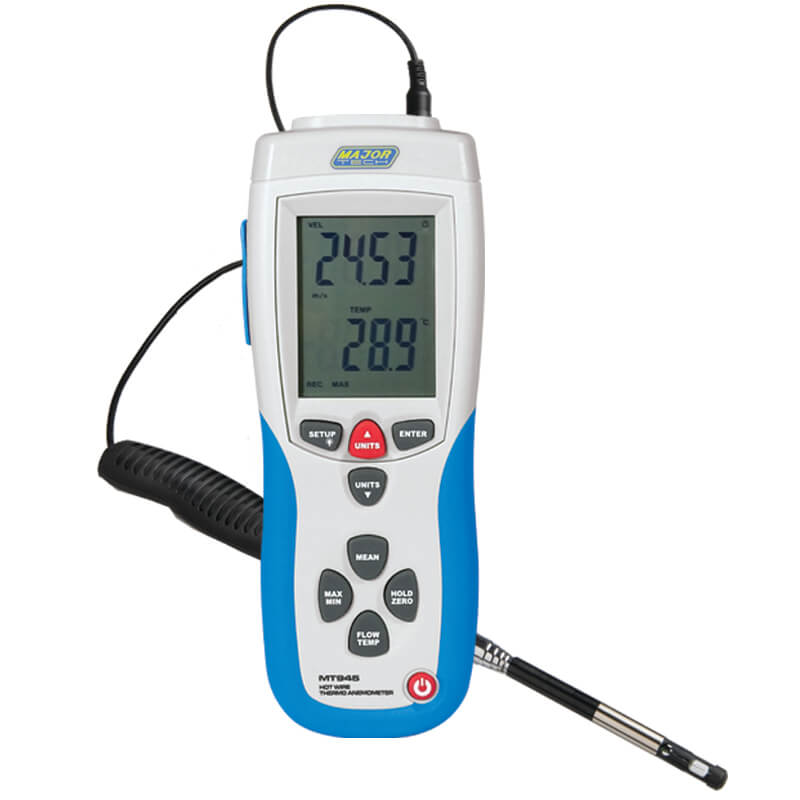How to Preserve and Care for Your Anemometer to Guarantee Longevity
How to Preserve and Care for Your Anemometer to Guarantee Longevity
Blog Article
All You Need to Learn About Anemometers: How They Work, Why They Matter, and Where to Use Them
Anemometers, though usually ignored in the world of scientific tools, play an essential function in various fields, supplying beneficial insights right into wind speed and air movement patterns. As we delve into the details of anemometer technology, we will discover the internal workings of these devices, their importance, and the crucial considerations when choosing the ideal anemometer for certain applications.

Anemometer Basics
A vital instrument made use of to measure wind rate and instructions, the anemometer plays an important duty in meteorology and numerous industries. An anemometer commonly consists of three or 4 cups that revolve in the wind, a vane that points into the wind, and sensors to track the turnings or movements.
There are numerous kinds of anemometers available, including mug anemometers, vane anemometers, hot-wire anemometers, and sonic anemometers, each with its one-of-a-kind attributes and applications. Cup anemometers are commonly utilized for fundamental wind rate measurements, while vane anemometers are preferred for directional measurements.
Principles of Anemometer Procedure
Building on the fundamental understanding of anemometer basics, the principles of anemometer operation illuminate the mechanics behind wind speed and instructions measurements. Anemometers operate the principle of air flow affecting a sensing unit, triggering it to revolve. Cup anemometers, for instance, have 3 or even more mugs that record the wind, creating them to rotate faster as the wind rate boosts. The rotation speed is after that exchanged a wind rate dimension. Vane anemometers, on the various other hand, utilize a tail or a probe that straightens itself with the wind direction, offering a measurement of wind instructions based upon the positioning of the sensing unit. Hot-wire anemometers depend on a warmed cord that cools as wind overlooks it, with the price of cooling down identifying the wind speed. Ultrasonic anemometers measure wind rate and direction by analyzing the time it considers ultrasonic signals to take a trip in between transducers. Understanding these principles is critical for exact and trustworthy wind dimensions in various applications.
Significance of Anemometers
Anemometers play an essential role in measuring wind speed and instructions, offering vital information for weather forecasting, climate studies, ecological monitoring, and aviation operations. Meteorologists rely on anemometers to collect exact wind information, aiding them recognize climate patterns, forecast tornados, and concern timely warnings to the public. Wind farm operators make use of anemometers to analyze wind problems and take full advantage of power manufacturing from wind generators.
Applications Throughout Numerous Industries
Applications of anemometers cover across diverse markets, showcasing their flexibility and energy beyond weather forecasting. In the renewable resource industry, anemometers play an important role in assessing wind problems for wind farm positionings, making sure ideal energy manufacturing. Industries like building and mining make use of anemometers to keep track of wind rates, essential for safety and security procedures, specifically when operating at heights or in open-pit mines where solid winds read review can position threats. Anemometers are likewise integral in the air travel sector, aiding pilots in comprehending airspeed and wind direction for risk-free liftoffs and touchdowns. The maritime market advantages from anemometers for ship navigation, aiding seafarers expect weather adjustments and adjust paths appropriately. In agriculture, anemometers help farmers in managing plant splashing by providing real-time data on wind rate to stay clear of drift. Anemometers locate applications in HVAC systems to enhance air flow and boost power performance in buildings. The diverse usage situations of anemometers emphasize their significance throughout different markets, highlighting their important duty in boosting functional safety and security and efficiency (anemometer).

Selecting the Right Anemometer for Your Requirements
For general functions, a cup anemometer is suitable for measuring wind speed, while a vane anemometer supplies wind direction data. Hot-wire anemometers are perfect for reduced airspeed dimensions, and ultrasonic anemometers supply high accuracy and durability.

Verdict
In final thought, anemometers play an important duty in measuring wind rate and instructions throughout numerous sectors. It is vital to consider the relevance of anemometers in order to make informed choices when selecting the most appropriate tool for gauging wind problems.
There are numerous types of anemometers available, including cup anemometers, vane anemometers, hot-wire anemometers, and sonic anemometers, each with its unique features and applications. Mug anemometers are typically used for fundamental wind check out here speed measurements, while vane anemometers are chosen for directional dimensions. Hot-wire anemometers are ideal for reduced airspeeds, and sonic anemometers are ideal for high-precision measurements in research study and industrial setups.Building on the foundational understanding of anemometer fundamentals, the concepts of anemometer procedure illuminate the auto mechanics behind wind rate and instructions dimensions. For general functions, a mug anemometer is ideal for gauging wind rate, while a vane anemometer offers wind direction data.
Report this page